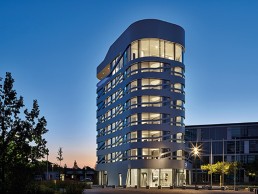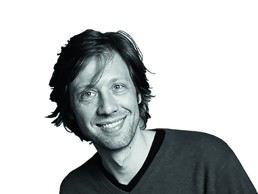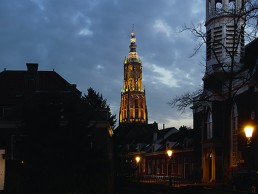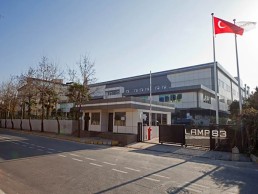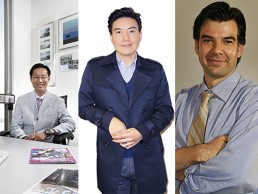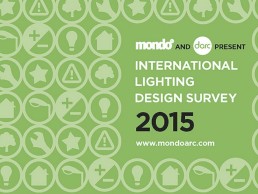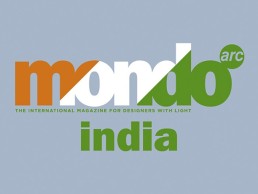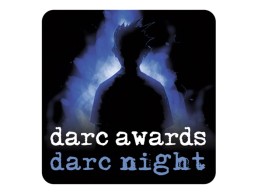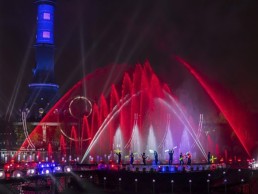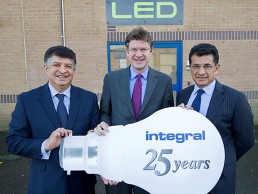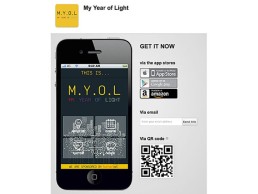IZB Residence, Germany
Design hotel IZB Residence, located in the heart of the Martinsried Life Science Campus, stands at an impressive 27-metres high - encompassing seven-storeys and featuring incisive, elegant design. Rising from a triangular floor plan, the IZB is designed as a faculty club serving as a meeting place for guests and scientists from the surrounding research facilities.
Designed by Stark Architekten of Munich, the building is a communicative focus of the campus, comprehensively lit by Occhio. In charge of the lighting design was Occhio's Helen Neumann, who commented: "The briefing given to us was simply a rendering of the building with its specific façade and the floor plans for each storey. Our first drafts showing the idea of curved ceiling trenches luckily struck with the architect immediately and after a year of refinement the harmonic result emerged.
"Together with Stark Architekten, we developed a lighting concept always keeping the 'bigger picture' and all-over result in mind." With the building’s front embraced by white aluminium strips, the internal lighting concept pursues the principles of connection: architecture, interior design and lighting blend together just as the internal spaces do. When visitors first enter the hotel they experience the continuation of the façade’s dynamics inside, through the reception and restaurant area. The dark suspended and decorative ceiling wells playfully mirror the curved design, while also assuming the function of a chain, onto which 123 surface-mounted Occhio Più alto spotlights are threaded. The rhythmic arrangement of the spotlights and luminaires enables the targeted lighting of the individual zones and at the same time guides the visitor through the space.
"The open floor plan concept for the public areas was supposed to appear consistently in one design," commented Neumann. "However, the different areas required different lighting atmospheres according to their purpose. We had the idea to design ceiling trenches that thread the luminaires like pearls on a string meaning they could be distributed among the space and create a calm ceiling view. Theses trenches became one of the signature features of the building.
"With the combination of LED and low-voltage halogen the different areas could be lit accordingly to their purpose by keeping one consistent luminaire design." Covering the first six floors of the IZB are twelve junior suites and 24 rooms, in which diverse areas of usable space are seamlessly interconnected and equipped with Occhio’s universal lighting. The workspace in each room is lit by a Sento tavolo table luminaire (42 in total), while the headboards are lit by a Sento letto wall luminaire (again, 42 in total are used). Where sitting areas are featured, a Sento lettura floor luminaire lights the space; and 36 of the rooms feature a Sento filo suspended from the ceiling into the room.
Along the hotel’s corridors, the walls are shaped with Duna shape spotlights marking access to the lift, helping to orientate the guests. At the same time they form a symbolic tree trunk through the entire building, right up to the top storey where the Faculty Club G2B (Gateway to Biotech) - the centrepiece of the building - is found. This 170 m² club room, with modern furnishings and a view of the Alps, serves more than 600 professors and some 100 managers and CEOs of the IZB on the campus, acting as a place for communication and the interdisciplinary interlocking of people and their ideas. The first member of the G2B was Professor Edvard Moser, winner of the Nobel Prize in medicine 2014.
The open ground plan of the club, which stretches across the entire story is divided into different function areas and includes a spacious bar area creating an inviting atmosphere for discussion, while high seating elements providing a private framework for gatherings, and a private dining area is available for business meals. There are 85 Duna shaped spotlights trailing across the ceiling – randomly arranged and providing functional lighting for the diverse areas, echoing the principle of the melding of architecture and lighting.
Concluding, Neumann added: "The greatest moment for me was seeing the building during the construction phase and then again after completion. Suddenly all the virtual pictures and 2D plans turned into reality and you could literally feel the harmony that emerged. A beautiful, organic and puristic interior with a very welcoming and sensitive ambience was achieved."
Rogier van der Heide
Why did you move from Philips to Zumtobel?
When I joined Philips it was an interesting moment in time because of the shift in lighting technology and the decisions that meant for a huge business like them. I had a great time but I wanted to work with a 100% lighting company. There are other lighting companies of course but Zumtobel has always been involved in application working closely with architects and lighting designers. I’m a lighting designer so this appealed to me. I’ve known the Zumtobel family for quite a while and we have had discussions in the past but there was always something getting in the way. Now was the right time.
What is your role at the Zumtobel Group?
My role (Head of Design and Marketing) is a very influential one, heading a small group of passionate people to drive the company forward. We are in a process of transformation. Based from what I saw at Light + Building we have some catching up to do. Ulrich Schumacher came on board as CEO just over a year ago and it’s his goal to make Zumtobel healthy and fit for a future that is faster. There will be an interaction between my creative vision and what we structure in our programmes to develop a cohesive portfolio of innovative products. The focus on LED by most of the lighting industry has been energy savings. Most of the big companies haven’t thought about what we can do with LED that we weren’t able to do before if we combine it with other technologies. That is starting to happen now and I want to be at the centre of that.
Do you have any specific goals for the Zumtobel Group brands?
I want to create an ecosystem rather than treat the three main brands (Zumtobel, Thorn and Tridonic) as separate entities. The approach to the market of the three brands has always been very different but by working closer together we have an ideal opportunity to give the market what it wants by simplifying the whole process. We are working on ideas but it would be great if every Thorn product had really intelligent, connected light for example. Why not? It doesn’t have to be just the really high end brands that have this. Why can’t Zumtobel have beautiful, aesthetic exterior products? There are no reasons why. I can’t tell you it will definitely happen but it’s a wish of mine.
Will you continue to work with architects and designers to develop products?
Yes, we will but we will also work with new talent, both from architecture and other disciplines, to come up with a new road map of ideas. It’s easy to hire a famous architect to design a product, pay a fee and then it gets specified on a few of their projects. But it’s not enough. We need to build relationships in which the continuous exchange of ideas gets established. For that you need to show your passion. Many large lighting companies fail to make real choices. They try to cover everything, they have huge complex catalogues but it’s too much for architects who have to think about every element of the building. Of course we still need catalogues but we should be talking with architects and others to create real lighting solutions, to make catalogues more relevant.
Will the policy of supporting lighting designers on projects continue?
Yes, we will always support lighting designers on projects where they are involved. But of course in some markets there are no lighting designers and in this case we can offer a service that includes lighting design. This doesn’t compromise lighting designers. On the contrary, everything we do at a high level grows the market for all. Lighting designers benefit the more great lighting design is out there. The reaction from lighting designers when the news came out that I was joining Zumtobel has been very positive. There’s a lot of love out there for Zumtobel!
Why is Zumtobel opening a Lichtforum in Amsterdam?
Unlike previous Lichtforums, it will be a centre for experimentation. The great architects and designers from the past like Frank Lloyd Wright, Charles and Ray Eames were not scared to experiment with materials to create and I think we need to be like this with light. We have to create lighting solutions with experts from other disciplines like the arts, science, healthcare or behavioural psychology or even app developers to drive a programme of innovation. I want to make smart lighting that is more holistically connected than just the driver and the lamp. I want to connect to the rest of the world. I have no idea how to do that yet but I want to find a way.
Why specifically Amsterdam?
It’s nothing to do with the fact that I live here! The language and travel connection advantages are obvious but Amsterdam is so creative in design, architecture and technology, with a lot of great talent. Many great architects are based in the Netherlands like Mecanoo, MVRDV, UNStudio, OMA etc. Hi-tech companies like Cisco, Google, Microsoft and IBM have their European headquarters here. They are all now looking at lighting and I am very interested in working with them. They don’t care about the mechanics of manufacturing lamps but they can bring some fresh ideas to the debate. Everyone at Zumtobel cares passionately about lighting and we can bring our expertise to the table.
You had some time between leaving Philips and joining Zumtobel. What did you get up to?
I was busy! I went back to my roots and did some small lighting design projects. I also had more time to dedicate to this year’s Amsterdam Light Festival (I’m the founder) which was very rewarding. And I am involved in a documentary film about light based on a theatre production of Prometheus: The Poem of Fire by Alexander Scriabin that I’m working on. Scriabin composed the piece about light in 1910 when electric light had just been invented. There have been several productions of it when lighting has been involved but this will have a modern, fully immersive lighting interpretation. It will be shown here in Amsterdam in December this year for the International Year of Light.
Onze Lieve Vrouwe, Netherlands
Standing at 98m tall, the Onze Lieve Vrouwe tower shines brightly over the geographical heart of the Netherlands, thanks to a lighting makeover by lighting designer Jeroen Jans.
While local authorities were enthusiastic about the project, there was no funding available and so Jans set up a non-profit organisation to raise the required funds in just nine months. Now considered a beacon for Amersfoort and its people, the tower’s lighting upgrade took two years to complete, with Jans envisioning the tower as “a magical structure projecting unity, balance and synergy through lighting.”
Jans’ main objectives were to drastically reduce light pollution and achieve a 50% reduction in power. In order to achieve this, the lighting had to work from the inside out, ensuring no external shining of beams onto the building, and no fixtures and fittings were visible. This vision was achieved with the help of light engineering company Lomans, which installed Osram Traxon and CLS LED lighting fixtures. The Osram fixtures includes two types of liners, the XB27 and XB36, both of which use different colour temperatures and lenses to give each part of the tower a specific texture.
There were 138 CLS LEDs supplied in three types of fixtures - the Revo-basic, the Revo compact and the Mirjam. Each fixture has its own lens and colour configuration and is relatively small so doesn’t affect the building’s architectural aesthetics. The Revo fixtures lower the power consumption and limit the loss of light to reduce light pollution, thereby exaggerating these aesthetic details with focussed and directed lighting. The Revo Series’ lenses are fully interchangeable, lighting all details of the tower thanks to the different beam angles.
The project was not without its challenges however and Jans described how it was difficult to fix anything to the tower without causing damage. In order to design skirting boards for the three long walkways, Jans worked closely with Cultural Heritage Agency of the Netherlands to come up with something that could be integrated with existing security fences. The newly lit tower was revealed in November last year with the local residents receiving it with enthusiasm and pride.
Lamp 83 expands
(Turkey) - Istanbul-based lighting manufacturer continues operations in new facility.
Istanbul Dudullu Organised Industrial Area, with an open area of 8.000 m2 and closed area of 14.000 m2, will facilitate the growth of Lamp 83.
With direct trademark exportation for more than 30 countries, Lamp 83 has a new production capacity of more than 1,000,000 pieces annually and fully-modernised machines/equipments.
Focusing on qualified personnel, Lamp 83 provides new experiences for both its personnel and customers in its new factory building. New facilities including gym room, hobby room, and a conference hall with 60 people capacity with “lighting stimulation centre and showroom” of 2,000 m2 will now be in use.
The new facility will officially open in spring to reveal the 52-year “journey of light” based on the company’s principles of “Proper Lighting”.
Whitegoods appoints new Sales and Marketing Director
(UK) - Whitegoods Lighting appoints Christopher Burridge as Sales & Marketing Director.
Burridge’s experience in lighting sales and management is key to Whitegoods’ focus on delivering world class service and project support.
Douglas James, Founder and Director of Whitegoods Lighting, commented: “Adding Chris to the Whitegoods team is a huge step forward for us and his experience and skill set will benefit all of us.”
Having previously worked for Light Projects and KKDC, Burridge will carry through to Whitegoods his role in the implementation of a solid sales team and ensuring excellent overall sales support for the industry. With a degree in mechanical engineering from Brunel University, Chris will also be involved in new product development and will be able to relate closely to Whitegoods customers, helping to ensure products offered directly address the needs of specifiers.
Burridge added: “I’m really excited about the future and the opportunity to be part of an established UK based manufacturer that produces high quality and well-designed products with a clear philosophy and identity.”
New executives for Crestron Asia
(Hong Kong) - Crestron Asia appoints new executive focusing on strategic growth initiatives.
The new team consists of Tony Yeung, Director of Crestron Asia, Harry Lam as Chief Operating Officer and Stuart Craig standing as Crestron Electronics US Chief Executive Officer.
Yeung leads the executive team with his background knowledge of the company, while Lam will oversee the company’s finance, administration and logistics. Lam is responsible for the alignment and prioritisation of company investments, while Craig will direct sales, marketing and support functions across the Asia Pacific region.
International Lighting Design Survey reveals growing profession
(International) - ILDS reveals almost 1,300 lighting design practices now operating throughout the world.
Now in its sixth year, the survey has expanded for the first time from the previous sample of 50 randomly selected lighting design practices to a questionnaire being sent to every lighting design practice (or lighting design division within an engineering firm) in the world. We have calculated that there are now approximately 1300 independent architectural lighting design practices / divisions operating throughout the world (up by another 100 since the survey last year!). These include overseas offices of lighting design firms but not multiple offices in the same country, as listed in the directory of this issue. For example, dpa are counted as three practices (UK, UAE and Japan) even though they have four offices (two in the UK - London and Oxfordshire).
Out of those contacted, 233 responded by filling in the survey that asked specific questions about employee numbers and gender, revenue and project numbers. For those that responded, a big ‘THANK YOU!’ is in order. A sample of 18% of a profession is good going in anyone’s books. If you didn’t respond then please do next time. It takes very little time and is a big help in acting as a barometer to your profession.
Out of the 1287 practices contacted, we calculate that 402 operate in the USA with 178 practices now trading in the UK. Germany and France are the next highest with 78 practices each. Next is Australia with 42, Japan with 35, closely followed by China with 31, Canada with 30, India with 29 and Italy with 28. Switzerland has 26 practices, the Netherlands has 24, the UAE has 22, Singapore and Hong Kong has 21 each, Sweden and Brazil has 19 each, Mexico comes next with 17, Spain has 14, the Nordic countries of Norway (12), Denmark and Finland (10 each) bring up the rear before we get into single figures.
Of course, the UK easily has the highest amount of lighting designers per capita with London accounting for over half (92) of the practices in Britain. Even New York City comes a distant second with 57 practices. Next is Tokyo with 26 practices. Most of the other countries have a much more even split of cities with, for example, Berlin having 15 and Paris 14 practices.
Most of the practices surveyed are small in scale with by far the most popular amount of employees being between 1-5 (39%). Next was 6-10 with 19% and sole traders make up 10% of the total. Interestingly, those with over 50 employees come in fifth on the list with 6% of all practices. There is probably an anomaly here though with the larger practices having dedicated personnel who tended to the survey.
Of those employees I am delighted to report that by far the most popular gender split is 50:50 with 23% of practices employing the same amount of females as they do males. Well done you!
It wasn’t all good news on the female front however as, unfortunately, the third most popular result is all male employees with 13% of the survey. 60:40 male/female is the second highest result with 15%.
Concerning the important issue of hard cash, it seems that most practices are making a modest turnover with over half (56%) of those surveyed stating that their annual revenue is less than $400,000. 23% of those surveyed stated that their annual revenue is less than $100,000. However, those that stated that their annual turnover was more than $1 million is 22% with almost $8 achieving over $5m annual revenue. This included practices across the board in the regions of USA, UK, Europe, Asia and Australia. Again, this figure could be skewed as most of the very large practices took part in the survey.
In terms of projects secured in 2014, again modesty was the theme with a third of all practices surveyed stating that they won the contracts of between 1-10 jobs. A quarter of those who completed the questionnaire said that they secured work on between 11-20 projects while 17% secured over 50 projects with over half of these coming from the USA.
This was borne out in the fact that most of the projects secured were national rather than overseas with 27% of practices stating that their work was entirely domestic. Almost half of those came from the States.
1-10 completed projects in 2014 came in at a whopping 53% of all practices surveyed with 10% completing more than 50 projects. Of all the projects in 2014, 37% of companies only completed projects on a national level with almost half of those coming from the States and a quarter coming from Asia. Almost 10% completed a 50:50 split of overseas and domestic projects with 5% completing entirely overseas projects.
The digital edition of the ILDS 2015 is available here...www.issuu.com/mondiale/docs/ilds15_digital_issuu
All subscribers to mondo*arc receive the ILDS free of charge. If you would like a printed edition and are not subscribed to mondo*arc you can subscribe here... www.arc-magazine.com/about/2337464/subscriptions.html
mondo*arc india to launch in March
(India) - New quality publication for designers and specifiers in India - joint venture between creative lighting company STIR and publishers of mondo*arc and darc.
mondo*arc and STIR, a creative lighting company based in Mumbai and New Delhi, are collaborating to launch mondo*arc india, a new magazine for designers with light in India.
mondo*arc comes to India at a time when the Indian economy is flourishing; and the Indian design and lighting community is brimming with innovations and ideas. Looking ahead into the International Year of Light 2015 and celebrating the first edition of mondo*arc outside the UK, we bring to you mondo*arc india.
Paul James, Publishing Editor of mondo*arc, stated: “We are delighted to partner STIR in this exciting venture. mondo*arc india will serve the growing community of architects and designers in India with inspirational and informative articles about designing with light. With the team in India's expertise and passion, I know that mondo*arc india will be a huge success and I am looking forward to coming to India for the launch in March.”
mondo*arc india is the first magazine in the country dedicated to designers with light. A combination of mondo*arc and darc magazines, it promises to deliver an international publication with greater Indian context - pertaining to industry professionals, brands prevalent in the Indian market, research and development initiatives as well as the local lighting design fraternity.
Mrinalini Ghadiok, Editor of mondo*arc india, commented: “We recognise that there is an imperative need to outline the importance of light and lighting. Even though light is considered a fundamental building block of an architectural space, lighting is treated as an isolated and subservient element to all other design factors. While the architecture and construction industries streamline their focus on material based aspects of design, it is essential to broaden their horizons to include lighting as a tool to articulate design.
“The most influential group, the specifiers, sees lighting as more functional than experiential. The challenge lies in elevating light and lighting from a mere peripheral role to a core consideration in the design process by the specifiers themselves.”
mondo*arc india intends to create a platform to educate and spread a keen awareness among specifiers, designers and architects, providing an arena suitable for discourse as well as inspiring them by demonstrating excellence. It aims to enrich, recognise and reward lighting designers; and become the most prominent growth catalyst for the Indian lighting industry.
mondo*arc india hopes to penetrate this idea deeper into the mindset of the subcontinent. Widening the audience base to include design discerning and high net worth individuals, the magazine will kindle a profound desire for deliberated design with light in the country. This would further encourage a greater growth in the lighting industry and therein create a superior market for its products.
Ghadiok continued: “Light is the invisible-visible that renders soul into a lifeless moment. Lighting is the discipline that sanctions this transformation. mondo*arc india aspires to become the platform by which we seek, inspire and reach out to an international rostrum of brilliance. Disseminating novel ideas, propagating pioneering philosophies, showcasing creative proficiencies; this publication will truly put the Indian design community and lighting industry ecosystem on the global map.”
mondo*arc india is a joint initiative between mondo*arc magazine ltd and STIR - See. Think. Inspire. Reflect. STIR has been conceived and founded in India as an international platform for light - for creativity in light, information on light, revelation through light and education about light. We facilitate promoting, creating and disseminating ideas related to light through a range of activities across the country.
To subscribe to mondo*arc india write to mondoarc@stir.lighting
To enquire about advertising on the launch issue write tomanisha@stir.lighting
darc awards welcome eight partners in time for launch
(UK) - High end lighting brands Concord, Innermost, KKDC, L&L Luce&Light, LSE Lighting, Lucent, Megaman and Reggiani commit to innovative international lighting design awards.
High end brands from architectural and decorative lighting have commited to becoming partners to the darc awards in time for the darc nightlaunch party where over 100 lighting designers will be in attendance. The party will take place at the incredible arts space Dilston Grove in Southwark, London on February 5th 2015 featuring a special lighting scheme by Light Collective and will also feature an animation by Kerem Asfuroglu of Speirs + Major with his Dark Source series. The darc awardsprocess will culminate in darc night in London in September 2015.
Each partner will be given the opportunity to collaborate with lighting designers to create a stunning installation in the awards venue via a series of lighting schemes as part of darc night, an atmospheric party in a unique venue in London with light art and street food. This breaks all the awards rules and will be unlike any other awards ceremony to date.
Paul James, awards director and publishing editor of mondo*arc and darc, commented: “I am absolutely delighted that such great lighting brands can see our vision for something new and original for lighting design awards. They could easily have said, 'Not another awards event!' but they saw the potential immediately and have very quickly come on board. To have eight partners already, before the launch, is incredible and testament to what we feel will be a superb initiative.”
Leading international lighting design publications mondo*arc and darchave teamed up with creative consultants Light Collective to create thedarc awards, a unique international architectural and decorative lighting design awards concept.
“With our database of 1,300 international lighting design practices, as well as interior designers and architects, there is a unique opportunity for every practice to get involved in the awards process,” commented James. “We intend to make the darc awards the most accessible and global awards programme ever - after the shortlists have been chosen by an expert panel of international lighting designers, each of the lighting design practices and their designers will be invited to vote on their favourite projects via our specially developed website. Using the model developed by the Oscars where all members vote on their peers' work, the darc awards will give every designer a vote, making this the only truly peer-to-peer lighting design awards in the world.”
All the projects and the companies who have submitted to the awards will be present on the website so that, over time, the darc awards website becomes a comprehensive online lighting design resource that can be used by designers and clients alike for inspiration and promotion.
There will also be product categories (two architectural and one decorative) that will follow the same philosophy resulting in a comprehensive online database of products. The products will be voted on by the very same lighting designers who are looking to use them in projects.
Martin Lupton and Sharon Stammers of Light Collective commented, “Having been involved in many lighting awards programs over many years, this is a great opportunity to build on all of those experiences and try to create a different version of celebrating the best of lighting design where the judging is in the hands of everybody. Helping to shape darc night in collaboration with mondo*arc has given us a chance to create an awards ceremony that is by the people, for the people - it’s the Oscars of lighting design!”
The darc awards has been welcomed by the lighting design profession. Nick Hoggett, Partner at dpa lighting consultants, said, “I feel the darc night concept is excellent because the projects will be assessed by a wide group of international independent lighting designers and established light artists. This will reflect a truly global opinion of well informed and experienced practitioners engaging many people in the judging process rather than the normal select few. I know the team behind this will deliver something completely different and special which will be refreshing amongst the plethora of awards programmes that feel so similar.”
mondo*arc and darc magazines are members of Lighting-Related Organizations (L-RO), a global professional community of people who work with light and lighting in the built environment, and is part of the United Nations - International Year of Light and Light-based Technologies 2015 (IYL2015).
The darc awards and darc night will be part of the IYL2015 related activities program and will be promoted by the L-RO to raise awareness for the lighting design profession and showcase the importance and beauty of light.
Circle of Light festival turns to SGM
(Russia) - SGM wash lights demonstrate applicability as waterproof luminaires at Circle of Light Festival.
Lighting designer Yury Krasilnikov orchestrated The Circle of Light festival held at Ostankino Tower, comprising water, laser and pyrotechnic shows as well as artists and water performances, culminating in a fireworks display.
For the water features of the festival, fountain specialist Aqua-Show installed two lines of fountains and created a 3D world of water for laser projection. Using RGBW P-5 wash lights from SGM, they illuminated the fountains were illuminated with water reaching heights of 30-metres.
Water show lighting designer and design engineer of the fountain system, Korzakov Anton, explained: “This is our first experience in using LED light for creating a wash effect on the water. All our previous attempts have been unsuccessful and for many years we have only used conventional lights.”
One fountain complex measured 18-metres long, equipped with 16 P-5s installed on the stage. Another was 52-metres, equipped with 26 P-5s installed on the lake 30-metres behind the stage.
Spin Music Service supplied the 42 LED fixtures matching all of the show’s requirements. “The light weight of the P-5 influenced our decision as well as the huge light output, but the main feature of the P-5 is the IP65 rating, as it is exposed to water from the fountains and the fixtures had to work a full week in these conditions,” said Anton.
The lighting designer had previously seen the P-5 in use for architectural installations, but never in connection with water. The result was a fitting display for the festival which received positive reviews from spectators.
Integral Memory in energy saving campaign
(UK) - Integral Memory calls for increased support for energy saving products.
According to Sunil Kotecha, Integral’s MD, an opportunity exists to build a Shenzhen style technology hub in Brent, North West London based on the demand for innovative energy saving lamps that are quickly replacing other forms of lighting.
During Integral Memory’s 25th anniversary celebrations, Rt Hon Greg Clark MP, Minister for Universities, Science and Cities (who officially opened a new LED Lighting Laboratory facility which is part of a package of new investment planned by the company to meet a growing demand) acknowledged Integral’s achievement of staying at the top of a fast moving technology markets for many years.
“Integral’s success is based on its agility to spot and respond to opportunities in a fast moving marketplace. The future demand for energy saving lighting is a key growth sector that both rewards the customer with lower energy bills whilst providing energy savings and helping our ability to achieve lower carbon emission targets,” said the Minister.
Within a series of keynote addresses at the launch event, speakers called for further investment to provide the essential training and skills required to meet the challenge of the global green technology market.
“As a government we have a responsibility to companies like Integral to ensure that the skills are available to ensure continued growth. The recently announced science and innovation strategy is designed to feed that need.” continued the Minister.
Referring to his early days as an engineer, Kotecha observed that opportunities for new graduates were fewer than in the mid-eighties when he entered the job market.
“As an experienced visitor and witness to China’s economic miracle - I know we have a considerable distance to cover in order to catch up to the level of skills, investment and infrastructure available to our manufacturing competition abroad,” he said. “Our strength as a country is in our ability to innovate. Hence the key to our future lies in nurturing the talent within our Universities and attracting them to fast growing market sectors like LED lighting.”
The future of LED lighting is very exciting according to experts present at the event and according to Tony Howells, Senior Policy Advisor to the Department of Business Innovation and Skills: “Lighting is everywhere and combined with the cost savings available of 60-80% that LED can offer - it is a total ‘no brainer’.
Couple this with a requirement to become less reliant on coal fired power stations and in our critical need to match government environmental targets - the LED lighting industry becomes one of the strategically important industrial sectors."
My Year of Light app launched
(UK) - New app launches for International Year of Light.
Considered a possible first for the market, developer of the app, Rhiannon West, Lighting Designer at UK-based BDP, told mondo*arc: "The app collates all the latest information, events, news and photographs to help promote 2015 in lighting."
Released in January this year, My Year Of Light offers an access platform of information, providing details of the latest events for the International Year Of Light. There is a live stream of photographs, news and an interactive map, bringing users in touch with the most up to date information for the year of light.
Free for download at 24.8 MB, M.Y.O.L. is compatible with iOS 7.0 software or later on the iPhone, iPad and iPod touch, optimised for the iPhone 5.
To access this online platform, providing all the latest events for the International Year Of Light, you can download the app via the Apple store or Google Play here: myol.mobapp.at


